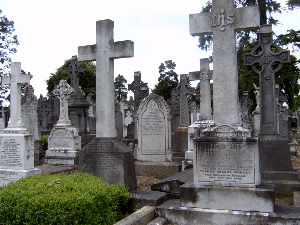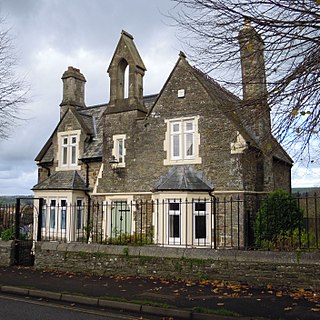Related Research Articles

Glasnevin Cemetery is a large cemetery in Glasnevin, Dublin, Ireland which opened in 1832. It holds the graves and memorials of several notable figures, and has a museum.

A cemetery, burial ground, gravesite, graveyard, or a green space called a memorial park, is a place where the remains of many dead people are buried or otherwise interred. The word cemetery implies that the land is specifically designated as a burial ground and originally applied to the Roman catacombs. The term graveyard is often used interchangeably with cemetery, but a graveyard primarily refers to a burial ground within a churchyard.

A grave is a location where a dead body is buried or interred after a funeral. Graves are usually located in special areas set aside for the purpose of burial, such as graveyards or cemeteries.

A dakhma, otherwise referred to as Tower of Silence, is a circular, raised structure built by Zoroastrians for excarnation, in order to avoid contamination of the soil and other natural elements by the decomposing dead bodies. Carrion birds, usually vultures and other scavengers, consume the flesh. Skeletal remains are gathered into a central pit where further weathering and continued breakdown occurs.

God's Acre is a churchyard, specifically the burial ground. The word comes from the German word Gottesacker, an ancient designation for a burial ground. The use of "Acre" is related to, but not derived from the unit of measurement and can be of any size. In the early 17th century the term was used as a translation of the German, but by the end of the century, it was accepted as an English term.

Rawalpindi Cricket Stadium is a cricket stadium located in Rawalpindi, Punjab province of Pakistan. It is located close to Pir Meher Ali Shah University and Rawalpindi Arts Council and has an estimated capacity of 18,000. The first international match at the stadium was played on 19 January 1992, when Sri Lanka faced Pakistan in an ODI. The stadium hosted its first Test match in 1993, when Zimbabwe toured Pakistan.

Cyrus Broacha is an Indian anchor, theatre personality, comedian, political satirist, columnist, podcaster and author. He is best known for his show Bakra on MTV India and The Week That Wasn't on CNN-News18.
The term Gujarati Muslim is usually used to signify an Indian Muslim from the state of Gujarat on the western coast of India. Most Gujarati Muslims have the Gujarati language as their mother tongue, but some communities have Urdu as their mother tongue. The majority of Gujarati Muslims are Sunni, with a minority of Shia groups.

The English coastal city of Brighton and Hove, made up of the formerly separate Boroughs of Brighton and Hove in East Sussex, has a wide range of cemeteries throughout its urban area. Many were established in the mid-19th century, a time in which the Victorian "cult of death" encouraged extravagant, expensive memorials set in carefully cultivated landscapes which were even recommended as tourist attractions. Some of the largest, such as the Extra Mural Cemetery and the Brighton and Preston Cemetery, were set in particularly impressive natural landscapes. Brighton and Hove City Council, the local authority responsible for public services in the city, manages seven cemeteries, one of which also has the city's main crematorium. An eighth cemetery and a second crematorium are owned by a private company. Many cemeteries are full and no longer accept new burials. The council maintains administrative offices and a mortuary at the Woodvale Cemetery, and employs a coroner and support staff.

New Calton Burial Ground is a burial ground in Edinburgh. It was built as an overspill and functional replacement to Old Calton Burial Ground and lies half a mile to its east on Regent Road in Edinburgh, Scotland, on the south-east slopes of Calton Hill. On its southern edge it attaches to the north-east edge of the Canongate in the Old Town. It lies on a fairly steep south-facing slope with views to Holyrood Palace, the Scottish Parliament Building and Arthur’s Seat.

Parsi Fire Temple is a place of worship for the Parsis in India. Located at MG Road in Secunderabad, Telangana, the temple is believed to have been consecrated in September 1847. The temple was built by two brothers and traders, Pestonji Meherji and Viccaji Meherji, who had settled down in Secunderabad. In addition to the temple, the compound also has residential and commercial buildings. The Parsi population in the twin cities of Hyderabad and Secunderabad is the second largest in India outside Mumbai.

The North Brisbane Burial Ground was a former cemetery in the Town of Brisbane, Queensland, Australia. It was in the area now known as the suburbs of Milton and Paddington. It was also known as North Brisbane Cemetery, Paddington Cemetery and Milton Cemetery.

The Ramshorn Cemetery is a cemetery in Scotland and one of Glasgow's older burial grounds, located within the Merchant City district, and along with its accompanying church, is owned by the University of Strathclyde. It has had various names, both official and unofficial: North West Parish Kirkyard; St David's Kirkyard; and Ramshorn and Blackfriars. The latter name tells of its link to Blackfriars Church, linking in turn to the pre-Reformation connection to the Blackfriars Monastery in Glasgow.

The Zoroastrian Trust Funds of Europe (ZTFE) is a religious, cultural and social organisation for Zoroastrians residing in Europe, particularly the United Kingdom. It was founded on 31 October 1861 by Muncherjee Hormusji Cama and Dadabhai Naoroji.
Malik Shakeel Awan is a Pakistani politician and businessman who served as a member of the National Assembly of Pakistan from 2010 to 2013.

Barnstaple Cemetery is the burial ground for the town of Barnstaple in Devon and is managed by North Devon Council.

The Jalan Kubor Cemetery is located across Victoria Street within the Rochor neighbourhood of the Central Region, Singapore. The currently disused cemetery contains over a thousand Muslim burials, including that of the royalty from the Johor Sultanate.

Greyfriars Burial Ground is an historic cemetery in Perth, Scotland. Dating to 1580, it is now Category A listed, with its collection of gravestones considered one of the best in Scotland. The cemetery closed to burials in 1978.
References
- ↑ "Rawalpindi: Parsi places of worship... still exist!". The Express Tribune . December 1, 2013.
- ↑ "The Parsi burial ground is a sign of Rawalpindi's rich heritage". Parsi Khabar. May 15, 2019.
- 1 2 3 4 5 Hassan, Shiraz (January 11, 2015). "For the lost Parsis of Pindi, a final resting place". DAWN.COM.
- ↑ "The Parsi burial ground is a sign of Pindi's rich heritage". May 7, 2019.
- ↑ "Shrinking as a people". Bol News .
- ↑ Shabir, Mahnoor. "The Parsi Cemetery of Rawalpindi". Youlin Magazine.